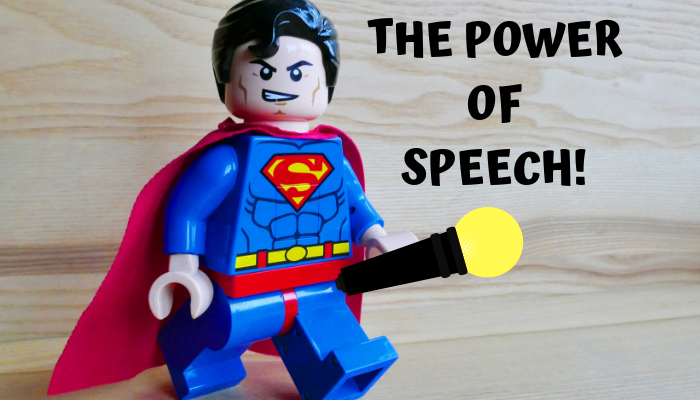6 PUBLIC SPEAKING BODY LANGUAGE MISTAKES YOU MUST AVOID AT ALL COST
I have always been fascinated by public speaking since young.
I love watching people deliver their speech.
I like to observe a speaker’s delivery style and learn from it.
Yes. Maybe you can call it an obsession…
But for me, it is a passion.
Based
on my so-called analysis, curiosity and self-learning, I have discovered a few
things along the way.
And
from the discovery, I have come up with my own interpretation of different speech
delivery techniques.
I also came to realize how important it is for any
speaker to pay attention to his or her body language when giving
a speech. Your body language can determine the success or the failure of your
speech.
Here
are 6 public speaking body language mistakes you must AVOID at all cost (Yes, I
named them myself…)
1)The Worrier
I have witnessed this many time.
The worrier (I called it) is a
speaker who likes to pace back and forth while speaking. The
worrier cannot seem to stand still and keep moving all the time when giving a
speech. It is so obvious that the audience can predict his or her movement.
Most
probably, the speaker is thinking too much. Maybe, the speaker is nervous and have
some difficulties facing the audience.
Why
should you avoid this?
By
walking back and forth, you are not communicating with your audience. You are
not looking at them. When you move too much, your audience will not be able to
concentrate to what you are saying. Instead they will be watching your
movement. They will get distracted and irritated at the same time.
2)The Statue
I am
sure you can make a guess what the statue means. The statue is a
speaker who likes to stand in one place and not moving much. The
statue is totally the opposite of the worrier. Beginners usually do this.
Experienced speakers mostly know how to move around appropriately.
Most
probably, the speaker is a nervous wreck. The speaker does not know how to move with purpose.
Why
should you avoid this?
Tell
me. Can you look at a statue for a long time? Eventually, you will get tired
looking at one direction. That is how your audience will feel if you keep
standing still at one place. Maybe your hand gestures might make a difference.
But by moving with purpose, it makes it easier for your audience to concentrate
on you.
3)The Dreamer
Dream,
dream away.
Yes.
Dream away I say.
The
dreamer is a speaker who likes to look up or look down when he
or she is speaking. The speaker’s eyes are always wondering
somewhere else and refrain from making any eye contact with the audience.
When
I was studying, many years ago, I still remember this one lecturer who refused
to look at his students when he spoke. He was one of the dreamers. He liked to
look up when he gave his lecture. But when we approached him and asked him some
questions, he would simply look down instead. I never understood why. Maybe he
was a shy person.
Why should you avoid this?
When
you give a speech, eye contact means everything. If you do not look at your
audience, do you think they will trust you? Having eye contact shows that you
believe in what you are saying. This proves your sincerity and confidence. How
can you convince your audience of your points, if you cannot even look straight
into their eyes?
4)The Reader
This is very common. I think you
must have seen this a lot. Yes, the reader
likes to read. However, I am not referring to the reading habit. Reading is a
good habit but not in this case. The reader is a speaker who likes to read when he or she is giving a
speech. The reader reads directly from
the notes, script or the visual aids. In other words, the speaker is not
delivering a speech. The speaker is actually reading the speech.
Maybe the speaker is not prepared.
The speaker is not ready for the speech. The speaker is not expected to give a
speech and the speech is prepared by someone else.
Why should you avoid this?
If the speaker is reading the
speech, why bother giving a speech in the first place? Reading from the script
or the visual aids shows that the speaker is not well-prepared and does not
take the speech seriously. Your audience will lose interest in you completely.
5)The Whisperer
Have
you ever listened to a speaker who seemed to be whispering? The whisperer is a
speaker who has a very soft unclear voice. The audience are not able to
hear anything, especially the audience who are seating at the back of the room.
From far, it looks as if the speaker is talking only to the audience who are
seating in the front row.
Maybe
the speaker has an unusual soft voice and unaware of the situation. The speaker
is not projecting his or her voice well. The speaker does not take the
initiatives to use any the microphones or make an audio check.
Why
You should Avoid this?
As a
speaker, your voice is a great asset. If you do not speak loud enough, your
audience cannot hear you. If your voice is unclear, your audience cannot
understand you. When this happen, they will not be listening to you. Many
people might not realize this; your voice is powerful enough to influence and
inject some emotions into the heart of others.
6)The Habitual
The
first thing you will notice when you watch the habitual in action, is the
predictable gestures. The habitual is a speaker who has
predictable gestures, hand and body movements. The habitual will do
the gestures repeatedly. For example, touching hair, pointing or adjusting the
blazer.
Most
probably, the speaker is nervous and this predictable repeatable movements
indicates the anxiety and tension. The speaker might also be too conscious
about appearance and want to look good. Or maybe, it is a habit hard to break.
Why should you avoid this?
When
you do the same gestures repeatedly, it will become obvious that your audience
will notice. This can be rather distracting for them. Instead of listening to
what you are saying, they will be observing your predictable movement and get
annoyed by it.
It is important to remember...
Public
speaking revolves around the speaker and the audience. Your audience’s
attention will be totally on you, at least at the beginning of your speech.
Therefore, your audience will notice even the smallest body gestures that you
make.
In
some cases, a speaker shows more than one of these body languages mentioned. I
know, we all might be guilty of these body language mistakes at some point. But
it is our duty to ensure that we do not repeat the same mistakes.
In order
to make a speech great, there is one thing to keep in mind.
A
great speech relies on two factors; speech content and speech delivery.
A good
speech content alone does not guarantee a great speech. The way the speaker
delivers the speech makes a huge difference. Your body language can give a
different outcome.
For
that reason, please avoid these body language mistakes at all cost!
Written By: Intan Salwana Anis
@2019 Public Speaking Is Cool. All Rights Reserved
@2019 Public Speaking Is Cool. All Rights Reserved



